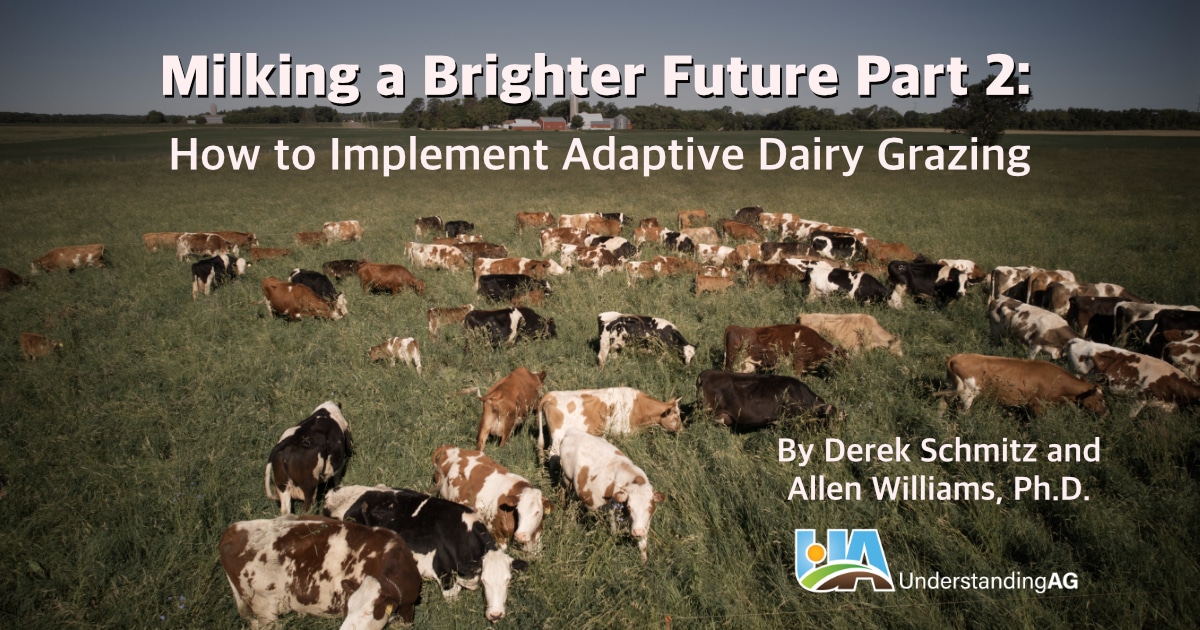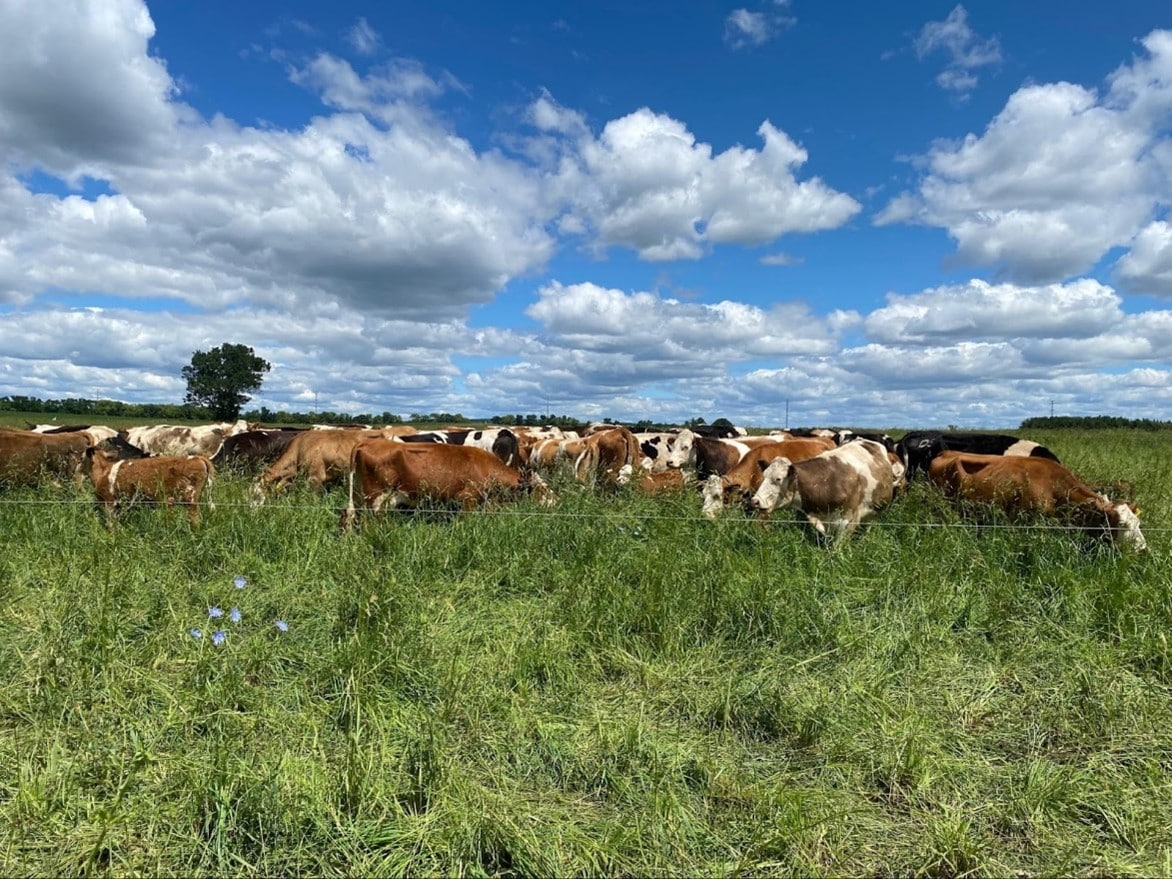
Adaptive grazing is a system of grazing that allows the grazer to continually adapt and flex to the real-life conditions that we face on an ongoing basis. It is not a prescriptive or formulaic approach. In applying adaptive grazing rules and practices across a wide variety of livestock enterprises and environments, we have found it to be, by far, the best grazing system for making continuous progress, increasing SOM, biomass production and biodiversity, and optimizing net profitability.
In prior articles, we have explored the Three Rules of Adaptive Stewardship’s Rule of Compounding, Rule of Diversity and Rule of Disruption, and how the intentional application of these three rules within your farm’s context allows you to achieve the highest levels of benefits.
In the dairy world, most producers are using some type of prescriptive approach in their grazing strategy, even though they may not believe they are being prescriptive. This prescriptive approach results in a narrowing of plant species diversity, compromised cow performance, suppressed soil microbial activity, which leads to lower mineral and water cycling, grazing season limitations and hitting a production ceiling.
Implementing Adaptive Grazing, particularly with extended paddock rest periods, can initially seem pretty daunting on the surface, but we can assure you it isn't difficult and is a worthy practice. But it goes against many of the “grazing rules'' we've been taught for 40-plus years including, “Graze a paddock every 20-25 days to keep everything vegetative,” or “You have to have at least a 30% legume component to supply nitrogen to grass” or "Make sure you clip a few times a year because a seed head in your pasture is a sin.” Unfortunately, these practices are not helping us nearly as much as we think they are. As a matter of fact, they can be detrimental to our progress and profits.
How to Get Started
So, let’s talk about how we can effectively implement longer rest periods, why should we use them and what they can do for us.
Let's start with why we should use them. The fastest way to improve soil health is a well-managed, highly diverse perennial pasture. But, when we’re grazing too frequently, or don't leave enough armor after a grazing event, we seriously impede and squander our resources (the use of the term “squander” is intentional). The main importance of using longer rest periods is to promote far more diverse pastures. Diverse pastures with plants at various stages of maturity allow the livestock to intentionally select plants to balance their needs, which promotes rumen health, reproduction, and overall health.
The plants in those pastures have been allowed to develop deep and interconnected root systems with strong mycorrhizal connections and supporting biology to foster phytonutrient richness that just can't be replicated any other way. These plants supply our livestock with a wide array of health-promoting and milk and meat quality-enhancing nutrients in every bite they take. This is simply not possible in low-diversity pastures.
When soil health is improved, stockpiled forages hold on to their quality much deeper into the fall and winter. Derek farms in central Minnesota and has had double-digit brix readings on various forages well into December. Being able to harvest dairy-quality feed grazing into the winter, with cows fed little supplement, is a real game changer.
Derek has also observed definite morphological changes in forages including dandelion leaves as long as your arm, broad-leaf plantain as big as a dinner plate and fescue that is soft textured and more palatable. Longer rest periods and better soil microbial activity facilitated this morphological shift. In particular, Derek notes plant morphology shifts when the soil is significantly more aggregated, which only happens with better mycorrhizal fungi populations.
As one of Derek’s grazing mentors says, “We are in the hospitality business. It is our job to provide a welcoming bed and breakfast to our guests; the biology that lives in and on thin films of water that surround aggregated soil.” If we aren't working to build those aggregates, keeping our soil covered or intentionally working to advance the diversity and complexity of our pastures, we are being poor hosts and our guests will leave.

Building Resilient and Diverse Pastures
To effectively make longer rest periods work we need to have a broad range of grasses, legumes and forbs. Most pastures lack this diversity. The conundrum is it takes diversity to make longer rest periods work and it takes longer rest periods to have diversity so the first practical step is to graze less of the total biomass available.
Rather than taking 50% or more on a grazing pass like on a 30-day rest period, Derek only takes about 30%. This provides a better-balanced diet for the cows. He may have to buy a little more feed the first year, but the longer-term benefits are worth it. You cannot immediately switch to 60-day rest periods so plan on gradually increasing the average rest period. You can skip some paddocks in the rotation and allow a longer rest for individual paddocks in a grazing season so you will not be grazing every pasture at 60-plus days rest every time. Derek’s rest periods typically vary from 40-80 days but does include some full-season rest as well.
Caution: If you practice a set-rotation pattern, grazing paddocks every 60 days, you are prescriptive and no longer adaptive which will reduce diversity and will lead to stagnation. Depending on the current stocking rate, you may have to slightly de-stock, add grazing acres, or be willing to use a little more feed. However, it will be worth it as you build more diversity and resilience into your farm.
Options for Increasing Diversity
Option 1: Inter-seeding complex mixes of perennial and/or annual forages into your grazing platform. This can be a great way to jumpstart your system but take it easy on the legumes. Native prairies were much lower in the legume component than many of our dairy pastures. Typically, these prairies were only 10-12% legume component, with a 30% or so forb component.
Option 2: Alternating a long-rest paddock with a shorter rest paddock. During the day, the bossies head to the long-rest paddock to take advantage of the cooling effect of the tall forages and shaded soil and in the evening they head to the less-rested shorter forages.
Option 3: Implementing leader-follower grazing. For example, you can have the lactating cows come through and “cream” the best 20% of the forage and then bring in the clean-up crew of heifers and dry cows to take another 20%+.
Option 4: If you are unsure and need to see what may happen, consider making an “exclosure.” An exclosure is a fenced-off area (using temporary fencing) that will not be grazed for an extended period of time during the active growing season. Be sure to make the exclosure large enough to be meaningful, at least 0.5 acres to several acres.
These practices may require higher-stocking densities than you are used to. We constantly vary stocking rates depending on pasture needs and weather conditions. Stock densities range from 100,000 pounds an acre up to 1.5 million pounds an acre at points throughout the grazing season. The yearly average on Derek’s farm is about 250,000 pounds/acre, which promotes competitive grazing and trample. Higher densities necessitate more frequent moves, but with today's grazing technology, this isn't difficult. Derek uses a combination of manual moves and solar-powered fence lifters to move the cows 3-8 times a day, usually in rectangular paddocks (long and narrow) to promote a higher degree of trample.
You may want to experiment with a field on “the back 40.” Derek picked a poorer field on his farm to give a 90-day rest and was pleasantly surprised when he found 10 new species there this fall, including several native warm-season plants. A few weeks after grazing, following the 90-day rest, plant density in that field improved dramatically and it looks better than it ever has.
Summary
Give Adaptive Grazing a try. It is well worth your time. You don't have to experiment right along the main highway (though we encourage you to do so to give neighbors something to talk about). This grazing approach is something we have repeated many times before on many different farms and the results are always worth the effort. In our next post, we will discuss how planned, purposeful disruptions, such as longer rest periods, improve livestock health and performance and livestock epigenetics.

